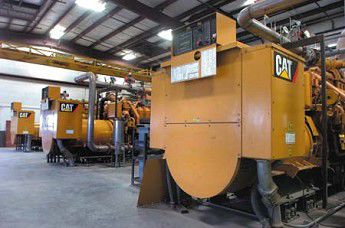Landfill gas put to good use
Published 6:08 pm Thursday, March 11, 2010

- Finley BioEnergy uses three Caterpillar Model 3520 engines to process methane gas into energy at its power plant west of the Finley Butte Landfill outside of Boardman.
Finley BioEnergy is a recycler. It uses a waste product to make electricity and heat.
Unlike two other power plants in Morrow County that burn fossil fuels to generate electricity, Finley BioEnergy burns methane. It also sells heat to a neighboring onion dehydration plant.
Trending
Finley BioEnergy, situated in the early morning shadow of the Finley Butte Landfill, draws methane gas from 57 landfill wells. The gas fuels three huge engines that power electrical generators.
Rick Morck, managing partner of Finley BioEnergy, said before his company began extracting the methane from the landfill in 2004, landfill owners simply burned it at the top of a flare tube.
Bacteria eat the decomposing organic material that is deposited in the landfill and give off methane.
“We pull the gas out as fast as the bugs produce it,” Morck said. “We’ve got a network of pipes all over that landfill.”
The $10 million project has been producing electricity for Pacific Power and heat for neighboring Cascade Specialties, an onion processor, since 2007.
Jan Mitchell of PacifiCorp, Pacific Power’s parent, said the utility has a qualified facility contract with Finley BioEnergy for its 4.8 megawatt capacity landfill gas project.
Trending
“The contract began in 2007 and runs through 2022,” Mitchell said, and the price is regulated by the Oregon Public Utility Commission.
Finley BioEnergy has installed three Caterpillar Model 3520 engines in a building just south of Cascade Specialties. Running at 1,200 rpm, each engine develops 2,400 horsepower, which is equal to about four D-8 Caterpillar tractors.
“They’re something bigger than you’d find in a big piece of equipment,” Morck said. “These are like engines that would power a ship.”
Morck said the methane gas from the landfill is about 120 degrees Fahrenheit, and moist, when it enters the pipelineon its way to the engines. A condensate pump removes the moisture.
Gas is visible rising from an open wellhead, much like one can see heat rising from hot pavement in the summer.
As the engines burn methane to produce power, they also produce two sources of heat for the onion dehydration plant. Finley BioEnergy recaptures heat from the engines’ water cooling system and from the exhaust stacks, sending water at about 234 degrees to Cascade Specialties.
Finley BioEnergy just started its fifth phase of operation in Morrow County. It is developing horizontal wells. The first 50 wells were drilled vertically into the landfill at a cost of about $15,000 each, Morck said.
Horizontal wells are much cheaper and simpler because they involve laying perforated pipe at various layers while workers deposit the garbage. Finley BioEnergy workers then connect solid high density polyethylene pipe to the perforated collectors and once the landfill is covered, connect the smaller pipes to a larger collector system.
“It’s the ideal pipe for this application,” Morck said. “It’s very, very tough.”
He picked up a pipe fitting, showing it to have a thickness of nearly half an inch.
The company’s network begins with 2-inch-diameter pipes, but the pipelines graduate to a 16-inch main line that transports methane to the generator building. Morck estimated Finley BioEnergy has a 3- to 4-mile-long pipeline network, mostly on the surface of the landfill.
“This garbage is pretty young garbage,” he said. “The population of bacteria that creates the methane will continue to multiply.”
Truckload after truckload of garbage is dumped at the landfill daily. Morck estimated it collects in excess of half a million tons annually.
“You have a lot of fuel arriving all the time,” he said.
Morck predicts a long future for Finley BioEnergy. He said there’s enough room for the landfill to operate for several decades, but even its closure wouldn’t end his company’s methane resource.
“We could probably operate 20 years after this place closes,” he said.









